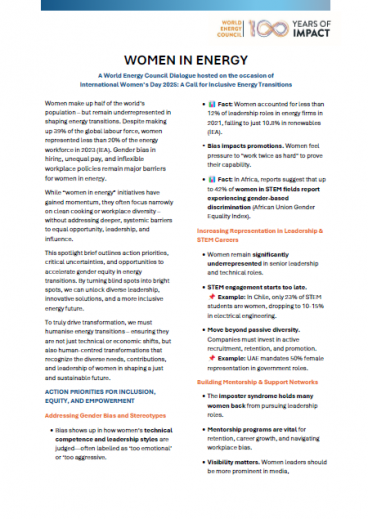‘How’ are you thinking about the futures of energy for people and planet?
This article was originally published by Dr Angela Wilkinson, Secretary General & CEO of the World Energy Council, via LinkedIn.
The steps to making energy transitions happen today are inspired by the stories we tell about tomorrow.
I have just spent the last two days at the Dubai Future Forum 2023, a gathering of over 1000 ‘futurists’ – experiential designers, scenario planners, systems transformers, social entrepreneurs, policy pathfinders and many other kinds of career choices and job titles that you wouldn’t normally associate with the challenges of climate change and energy transitions, decarbonisation and delivering net zero by 2050. Sincere thanks and congratulations for an inspired and inspiring event Patrick Noack and the Dubai Future Foundation.
On Monday, eight International Space Station astronauts shared their unique and intense experiences of collaborating above the planet as their lives literally depended on one another. Their near space experiences also reshaped their perspectives on humanity. The immensity of deep space was contrasted with the fragility of life on a blue-green planet surrounded by a veneer of atmosphere.
It's not science fiction to remind ourselves that, as humanity reaches for the stars, we are all astronauts and in danger of poisoning our own oxygen supply.
That said, questions of how to make the future better - for everyone and everything – and the “who with”, “for what”, and “by when” of future making were common threads of the vibrant conversations at this year’s Futures Forum.
I am once again reminded by the futurists who gathered in Dubai that ‘how’ we think about the future, shapes what we think and do now about today’s challenges and solutions:
- Futurists tend not to think about the future in terms of passive hope and fear – but rather as a resource and a breathing space for actively anticipating and exploring how to turn the twists and corners of the future into new and better possibilities.
- The future is first and always a story - which can be told using numbers, narratives and images. Whatever story is being told reflects deeply held worldviews and myths about the way the world works or should work.
- The future is not empty and still waiting to come, but rather unevenly distributed and can be experienced through simulated and embodied experiences.
It is a timely reminder ahead of COP28 that ‘how’ we think and talk about the future – critically, creatively, systemically, inclusively - shapes what we think and do about today’s urgent and important challenges.
As I prepare for COP28 UAE, I am actively listening and picking up signals of at least four different sets of stories:
- Heroes and Villains – who is to blame for climate change and who can be trusted to save humanity? This theatrical storytelling leaves us stuck in the present.
- Moonshots and Earthshots – harnessing the power of new innovation ecosystems and pulling the big ‘levers’ of markets and states. Stories of systems shifts and tipping points.
- Hundreds and Thousands – millions of seeds, blown by the wind of change, which can grow in diverse and adverse conditions. Becoming part of the story of change you want to see, empowered by citizen science, open data and empathy.
- Science Fictions Into Facts – can Generative Artificial Intelligence augment and save humanity from itself and secure a lot more clean and affordable energy for all along the way? How might a new genre of Cli-Fi (climate fiction) help catalyse imagination of new solution spaces e.g. geoengineering, carbon quantitative easing?
Over the next 12 days, we will hear more about the significant impact of action agenda initiatives being launched by Dr. Sultan Al Jaber and the COP28 UAE team aimed at accelerating decarbonisation, delivering net zero by 2050, and harnessing innovation to secure more energy for billions of better lives and a healthy planet.
As we do so, I encourage all my fellow delegates and attendees to keep in mind that how we speak about the future shapes the solutions we design and implement.
In the human centric stories we are creating to make faster, fairer and more far reaching energy transitions happen, people and diverse communities are active authors with the agency to shape and direct user-centric services and solutions which are accessible, affordable and acceptable in meeting their energy challenges and needs.
Which new and different stories of the future are you telling, hearing and helping to create?






_-80_result_688_387_s_c1_c_c.jpg)

